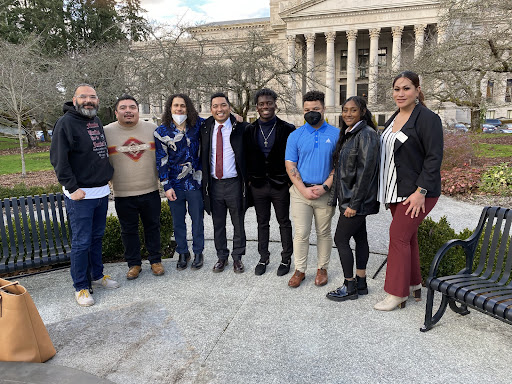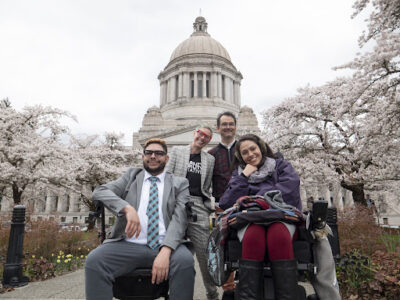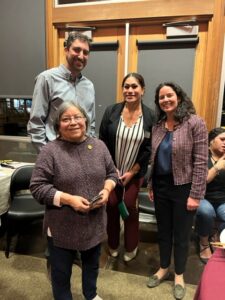
Realizing a Just Transition that restores, preserves, and protects communities most impacted by our changing climate requires real investments and a new way of measuring what a healthy economy looks like.
The Washington State Legislature wrapped up the 2023 legislative session in late April. There was a lot on the line this year as the legislature was responsible for, among other things, creating a new two-year state budget, responding to climate and environmental challenges, and tackling other issues related to housing, homelessness, drug possession, and the ongoing mental health crisis.
Prior to each session we work with our coalition of community of color organizations across the state to build a legislative agenda that truly represents and is accountable to the needs and solutions offered by frontline communities. Through listening sessions, work groups, our policy assembly and committee, and statewide membership summit, we put forward our 2023 Just Transition Agenda for Washington State.
Our Just Transition Agenda
Our agenda aimed to build upon the work of the Healthy Environmental for All (HEAL) Act, Move Ahead Washington, and the Clean Energy Transformation Act, policies we helped shape and pass in previous sessions, and to ensure the legislature meets its obligation to prioritize frontline communities and invest in programs and projects that reduce health disparities in Washington State.
A recap of our priority areas:
- Investments in Frontline Communities: Make certain that all state funds live up to the HEAL Act goal that 40% of any environment-related funds create environmental benefits to vulnerable populations and overburdened communities, and prevent or eliminate harm.
- Climate and Environmental Justice Planning: Require climate and environmental justice to be integrated in city and county comprehensive planning.
- Transportation Justice: Create a new state account and redirect large investments towards closing the gaps in our transit service and safe sidewalks, and a state transportation budget that supports climate justice and mobility justice for all.
- Energy Justice: Create a statewide energy assistance program designed to champion and ensure universally accessible energy assistance to lower- and moderate-income energy customers.
Ultimately, all of these priorities move away from harmful practices of the past and move us toward healthier communities. But to do that, we need policies and budgets that reflect the needs of our communities.
The Budget, and Climate Revenue
Unlike previous sessions, Front and Centered’s advocacy this year focused heavily on the state’s operating budget and new investments focused on the revenue generated by the federal government and the Climate Commitment Act (CCA).
 The 2023–2025 state budget is roughly $70 billion, with almost $2 billion of that coming from CCA revenue. Front and Centered opposed the cap-and-trade program in the CCA because it lets most industries off the hook, but we have continuously proposed and advocate for equitable climate investments, including co-creating Initiative 1631, the basis for the CCA investment framework.
The 2023–2025 state budget is roughly $70 billion, with almost $2 billion of that coming from CCA revenue. Front and Centered opposed the cap-and-trade program in the CCA because it lets most industries off the hook, but we have continuously proposed and advocate for equitable climate investments, including co-creating Initiative 1631, the basis for the CCA investment framework.
The HEAL Act and the CCA, both of which passed in 2021, mandated that the legislature spend at least 35% of new revenue on projects that positively benefit overburdened communities and another 10% set aside for projects approved by Tribes. With CCA revenue potentially exceeding $2 billion, there would be well over $900 million to be allocated to overburdened communities in the next two years alone.
We started this session by asking critical but sometimes overlooked questions:
- How will the legislature identify overburdened communities?
- How will they apply the criteria that demonstrates whether a project or investment is benefiting the community?
- How will the legislation justify their investments? What is their explanation for how their line items meet the required 45% goal?
So, after 105 days, how did our legislative priorities shape up and how did the legislature ultimately allocate new revenue related to climate and environmental planning?
Where the Legislative Session Landed Us
While we are celebrating new investments in community capacity, participation, and resiliency, we are questioning some of the decisions made by budget leaders to leave environmental justice out of the picture and are frustrated by the lack of action around critical community needs despite the availability of significant new revenues.
We are still in the process of making sense of all the budget allocations made this session — this process will play out over many months as state agencies don’t receive this funding until the summer. Agencies should be preparing to answer how these dollars will meet their obligations to benefit the households and families who need it the most.
What Our Coalition Achieved
Climate Planning in the Growth Management Act: Our biggest policy win this session is the passage of HB 1181, which created a new standalone element in Washington State’s Growth Management Act to address both the growing impacts of climate change and the state’s contribution to greenhouse gas pollution, with a focus on transportation. Front and Centered led the effort to incorporate environmental justice in this bill over multiple years. The budget included $40 million toward implementation of this bill, including grants to community-based organizations to advocate for their needs in the plan as a result of our advocacy.
Community Participatory Solutions: A core component of environmental justice is the participation of communities in the decisions that impact their health and their future. The final budget reflects this by including investments in participatory budgeting ($36.6 million) and community capacity grants ($26.3 million) to help boost the participation of our frontline communities in the implementation of the Healthy Environment for All (HEAL) Act and application of the state’s Environmental Health Disparities (EHD) Map. This wouldn’t have happened without pressure from our frontline communities, and was bolstered by the Environmental Justice Council that was established by the HEAL Act.
Transportation Justice: One quarter of Washington’s population does not or cannot drive and must rely on local transit options and walking, rolling, or biking. Safe, reliable, and widely accessible sidewalks are necessary for our communities to thrive. Yet too often, community members with accessibility needs have been left to ride a bus extra stops to get to an accessible grocery store.
does not or cannot drive and must rely on local transit options and walking, rolling, or biking. Safe, reliable, and widely accessible sidewalks are necessary for our communities to thrive. Yet too often, community members with accessibility needs have been left to ride a bus extra stops to get to an accessible grocery store.
We were successful in leading the advocacy for and securing $5 million to start working with the University of Washington and the WA Department of Transportation on mapping current sidewalk accessibility across the state and identifying gaps that must be filled. We hope this mapping project helps us create more walkable and rollable cities. See video below of our Rally for Accessible Sidewalks featuring BMAC.
Disproportionately Impacted Workers: Front and Centered and Community to Community led efforts to achieve a $10 million investment supporting a workplace health and safety program for workers affected by climate impacts, including extreme heat and cold, wildfire smoke, drought, and flooding. This program aims to support farmworkers, construction workers, and other workers who face the most risk from climate-related environmental impacts.
Energy Justice: Depending on where you live, you either get your power from a locally-owned, independently-owned, or cooperatively-owned utility district. Each district administers its own energy assistance program whose eligibility can vary on income levels and energy need, but we know and the Department of Commerce’s Low Income Energy Assistance Report shows that there are limits to existing bill assistance programs that can be addressed through a statewide approach. We were successful in securing $300,000 for a study that will recommend pathways to develop a consistent and equitable statewide energy assistance program.
Where the Legislature Fell Short
Environmental Justice in the Growth Management Act (SB 5651): Our bill to build an environmental justice (EJ) element into local comprehensive planning—beyond climate—stalled in the Senate Ways and Means Committee, leading to a budget proviso effort that ultimately got subsumed by other updates to comprehensive planning. While we are excited to see the state pass HB 1181, which does mention EJ in transportation, land use, and climate, we cannot continue this practice of making comprehensive plans that do not account for environmental health disparities across all planning elements. This new element would have supported equitable land use and environmental planning by city planners, as well as efforts to reduce existing health disparities.
Statewide Frequent Transit Standard: Washington State needs a comprehensive, statewide approach to transportation in order for residents to have frequent, accessible, and free public transportation. Through our work last session to support a Frequent Transit Study, we confirmed a major issue for nondrivers in our state: only 7% of Washingtonians have access to frequent and accessible transit routes which we define as a transit system that runs at least every fifteen minutes and can take people to and from their destinations without needing a car. This is illustrated by the Washington Transit Access Map, which we created in collaboration with Center for Neighborhood Technologies.
We aimed to codify a statewide transit standard in law that would result in better local transit. While our proviso was included in the Senate’s first transportation draft budget, it was not included in the House version and did not end up in the final transportation budget.
Continued Expansion of Highways: Besides failing to fund a reliable source of transit operating funds, the legislature doubled down on climate and environmental injustice by continuing to spend enormous amounts of money on expanding highways that enable pollution and using climate money on funds for ferries that could be funded by the gas tax. Even Governor Inslee agrees that these highway mega projects are a boondoggle.
Long-term Community Participatory Infrastructure: Although we made strides in community participation, the legislature failed to fund the Just Futures Statewide Community Assemblies, a process to build long-term capacity for Just Transition work in communities that impacts state government beyond climate change and the environment. Unless frontline community organizations’ capacity to assemble, align, and mobilize is properly resourced, others with more institutional power will continue to speak for us and community engagement will remain a symbolic exercise.
Our Coalition’s Advocacy
With each session, we work to improve and grow our advocacy and impact and it all starts well before session by listening to and engaging our coalition to create our priorities together. I’m in Olympia advocating full time during session and joined by members and staff showing up to testify and meet with legislators.
In February, we hosted a mini-lobby day with members from Utopia, Urban League of Metropolitan Seattle, Na’ah Illahee Fund, Mason County Climate Justice, and Community to Community. We also held our inaugural legislative reception with an impressive turnout by members, allies, and Members of Color from the House and the Senate. In April, advocates from BIPOC Mobility Action Coalition (BMAC) visited Olympia to discuss just transportation, hear directly from WSDOT policy staff, and hold a press conference (see video above).
from Utopia, Urban League of Metropolitan Seattle, Na’ah Illahee Fund, Mason County Climate Justice, and Community to Community. We also held our inaugural legislative reception with an impressive turnout by members, allies, and Members of Color from the House and the Senate. In April, advocates from BIPOC Mobility Action Coalition (BMAC) visited Olympia to discuss just transportation, hear directly from WSDOT policy staff, and hold a press conference (see video above).
We keep our members and supporters informed and engaged through regular meetings, emails, the HYLO platform, social media, and more. The response to our calls to action is constantly growing: thousands of people virtually signed in PRO for our priority bills and nearly 500 personal emails were sent to legislators asking that they support a budget prioritizing our communities. We speak to even larger audiences via our earned media strategy—centering the voices of frontline communities who know the solutions we need— appearing in outlets ranging from The Seattle Times, The Urbanist, and the White House!
What Comes Next?
Transparency and Accountability: The investment tracking language in the operating budget we asked for is a good starting point. We will need to embed language that clearly states that a project or grant is specially meant to positively benefit overburdened communities and accountability to frontline community demands for every climate and environmental dollar spent.
More Opportunities for In-person Advocacy: Hopefully, this session marks the beginning of many future opportunities for our members, supporters, and lawmakers who support the Just Transition movement to engage, learn, and make progress.
Lastly, while the last few months our coalition has spent a lot of our time and attention on the legislative process and its implications, the ongoing, day-to-day work on the ground creating real change with our members and our frontline communities continues throughout the year. We will continue to organize, mobilize, celebrate, and build a Just Transition in Washington State.


